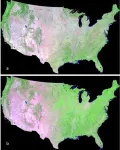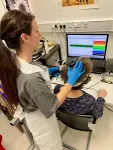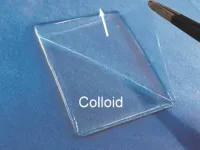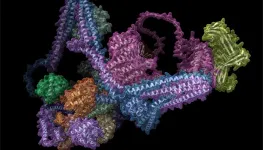(Press-News.org) Answers could be cloudy for researchers using Landsat images to investigate the coverage of the continental United States. The National Land Cover Database (NLCD) are useful products for scientists to understand how things like tree canopy and road coverage changes over time, but something as simple as cloud coverage can be misinterpreted in the satellite images as a significant surface coverage change. How can researchers be sure they’re getting a truly representative understanding of any one area?
The answer lies in composite images — for which researchers with the U.S. Geological Survey (USGS) and the University of Connecticut have developed a new strategy to produce clean images.
They published their approach on Feb. 21 in the Journal of Remote Sensing
“Our goal was to produce clean Landsat — the satellite program that monitors Earth’s surface for natural and human-caused changes — images without clouds and cloud shadows,” said corresponding author Suming Jin, physical scientist with USGS Earth Resources Observation and Science (EROS) Center. “We need consistent and clean Landsat images without any gaps to help prepare for large operational applications, such as mapping land cover or detecting changes.”
The National Land Cover Database (NLCD), established in 2001, is updated every 2-3 years with satellite images categorized by tree covers, urban areas, roads and more. NLCD has had eight epochs so far, with the most recent database available was released in 2019 . Before NLCD 2019, images from 435 pathways — or organized rows Landsat follows as it collects images — were used to map the continental United States.
“Despite the best efforts of the NLCD operation team to acquire a single leaf-on image with less than 20% cloud cover from the target year, a mean of 70% of individual Landsat images were from the seven target years, 25% of images were one year deviated from the target years, and 5% of images were more than one year off,” Jin said.
When Landsat cannot capture a clear enough image in a specific year, the dataset is filled in with images from other years. This provides a better understanding than having no image of a particular area, but land coverage can change significantly in a year or more.
“Substantial time and effort were spent on producing the final clear Landsat images, which included cloud and shadow detection, a gap-filling method and hand editing,” Jin said. “To shorten the latency of producing the new NLCD product and to reduce the amount of work needed to process individual-date Landsat imagery, we developed a more efficient image compositing strategy to generate clean images.”
The researchers developed an algorithm that selects an image pixel from a single date over time — such as June 5 over a set time window — that is as close as possible to the virtual median-value point. This virtual point has a median value from each band of all valid observations. The team also developed a method to detect and replace clouds and cloud shadows pixels on composite images. For example, for an image pixel of a forested area, the algorithm may identify that a clouded area isn’t a different type of coverage by comparing it to surrounding points. It can then splice images together to correct gaps or otherwise misunderstood information.
“We developed a new and straightforward image compositing method,” Jin said. “Our algorithm was shown to produce the best results for seasonal composites in the spectral and application evaluations among 10 compositing algorithms.”
This method was also applied to the National Land Cover Database 2019 data and produced the final clean images, which were released in July 2021.
“The new strategy not only solves the issue of residual cloud, shadow and missing-value areas on composite images, but also reduces redundancy and improves efficiency by reducing overlap areas among mapping units compared to using individual Landsat path/row scenes,” Jin said. “The new strategy for producing clean Landsat composite images improved both National Land Cover Database 2019 operational efficiency and quality.”
Co-authors include Jon Dewitz, also with EROS; Patrick Danielson, Brian Granneman and Kelcy Smith, KBR — contractor to EROS; Catherine Costello, USGS, Geoscience and Environmental Change Science Center; and Zhe Zhu, Department of Natural Resources and the Environment, University of Connecticut.
The USGS and the USGS-NASA Landsat Science Team supported this work.
END
New composite strategy leaves coverage questions behind, researchers report
2023-05-11
ELSE PRESS RELEASES FROM THIS DATE:
Comparison of depression and anxiety following self-reported COVID-19–like symptoms vs SARS-CoV-2 seropositivity
2023-05-11
About The Study: In this study of more than 45,000 individuals drawn from the French general population, COVID-19–like symptoms, but not SARS-CoV-2 infection, during the first months of the pandemic were associated with an increased occurrence of subsequent depression and anxiety eight months or more after the occurrence of COVID-19–like symptoms, even when SARS-CoV-2 serologic test results were negative.
Authors: Alexandra Rouquette, M.D., Ph.D., of the Université de Versailles Saint-Quentin-en-Yvelines in Paris, is the corresponding ...
Trends in the prevalence of functional limitations among cancer survivors
2023-05-11
About The Study: The number of U.S. cancer survivors with self-reported functional limitation has more than doubled during the past 20 years, with relatively less growth in the number of limitation-free survivors.
Authors: Vishal R. Patel, B.S., of the University of Texas at Austin, is the corresponding author.
To access the embargoed study: Visit our For The Media website at this link https://media.jamanetwork.com/
(doi:10.1001/jamaoncol.2023.1180)
Editor’s Note: Please see the article for additional information, including other authors, ...
New Utah study finds antibiotic stewardship program significantly reduced prescribing rates of antibiotics at urgent care centers in promising initiative to curb antibiotic overuse
2023-05-11
Overuse of antibiotic prescriptions for patients with upper respiratory illnesses at urgent care clinics in the United States has been an ongoing challenge, but a new study led by researchers at two Utah health systems – Intermountain Health and University of Utah Health – finds that a targeted approach utilizing antibiotic stewardship practices significantly reduces overuse of these medications.
In this Centers for Disease Control and Prevention (CDC) funded study, published today in JAMA Network ...
Obesity accelerates loss of COVID-19 vaccination immunity, study finds
2023-05-11
University of Cambridge media release
Obesity accelerates loss of COVID-19 vaccination immunity, study finds
UNDER STRICT EMBARGO UNTIL 16:00 (UK TIME) / 11:00 (US ET) ON THURSDAY 11 MAY 2023
The protection offered by COVID-19 vaccination declines more rapidly in people with severe obesity than in those with normal weight, scientists at the Universities of Cambridge and Edinburgh have found. The study suggests that people with obesity are likely to need more frequent booster doses to maintain their immunity.
Clinical trials have shown that COVID-19 vaccines are highly effective at reducing symptoms, hospitalisation and deaths ...
Milk reaction inspires new way to make highly conductive gel films
2023-05-11
A common chemical reaction that most people have seen first-hand is the inspiration for a new way to make a flexible gel film that could lead to innovations in sensors, batteries, robotics and more.
A research team led by Texas Engineers developed what they call a "dip-and-peel" strategy for simple and rapid fabrication of two-dimensional ionogel membranes. By dipping sustainable biomass materials in certain solvents, molecules naturally respond by arranging themselves into functional thin films at the edge of the material that can easily be removed using nothing more than a simple set ...
New study outlines how brain cancer cells take mitochondria from healthy cells to grow and survive
2023-05-11
Glioblastoma cancer cells use mitochondria from the central nervous system to grow and form more aggressive tumors, according to new Cleveland Clinic-led findings published in Nature Cancer.
The research showed that it is common for healthy astrocytes – a type of glial cell with important functions in the central nervous system – to transfer the energy-producing organelles to glioblastoma cancer cells. When this process happens, it makes the cancer more deadly and the tumors more likely to grow. Researchers found that acquiring mitochondria ...
Next-generation statistical simulator gives medical and biological researchers a benchmarking tool capable of closely mimicking single-cell and spatial genomics data
2023-05-11
UCLA researchers have developed an “all-in-one,” next-generation statistical simulator capable of assimilating a wide range of information to generate realistic synthetic data and provide a benchmarking tool for medical and biological researchers who use advanced technologies to study diseases and potential therapies. Specifically, the new computer-modeling – or “in silico” – system can help researchers evaluate and validate computational methods.
Single-cell RNA sequencing, called single-cell transcriptomics, is the foundation for analyzing genetic makeup (genome-wide gene ...
Gene-editing technique could speed up study of cancer mutations
2023-05-11
CAMBRIDGE, MA -- Genomic studies of cancer patients have revealed thousands of mutations linked to tumor development. However, for the vast majority of those mutations, researchers are unsure of how they contribute to cancer because there’s no easy way to study them in animal models.
In an advance that could help scientists make a dent in that long list of unexplored mutations, MIT researchers have developed a way to easily engineer specific cancer-linked mutations into mouse models.
Using this technique, which ...
HudsonAlpha Institute for Biotechnology wins $1 million NSF Engines Development Award
2023-05-11
[HUNTSVILLE, ALABAMA] May 11, 2023 – HudsonAlpha Institute for Biotechnology, along with several regional collaborators, was awarded $1 million from the US National Science Foundation's Regional Innovation Engines, or NSF Engines, program. They are among the more than 40 unique teams to receive one of the first-ever NSF Engines Development Awards, which aim to help partners collaborate and create economic, societal, and technological opportunities for their regions.
The funded project, entitled “Advancing carbon-neutral crop technologies to develop sustainable consumer goods (AL, GA, NC, TN)” (“Greening the Southeast” ...
AI helps map the postal workers in cells
2023-05-11
University of Queensland researchers have used artificial intelligence to build a 3D map of key cell components to better understand dementia and infectious diseases including COVID-19.
Professor Brett Collins from UQ’s Institute for Molecular Bioscience and Professor Pete Cullen from the University of Bristol led a team that modelled the 16 subunit Commander complex, a bundle of proteins that act as ‘postal workers’ in cells.
“Just as the postal system has processes to transport ...




